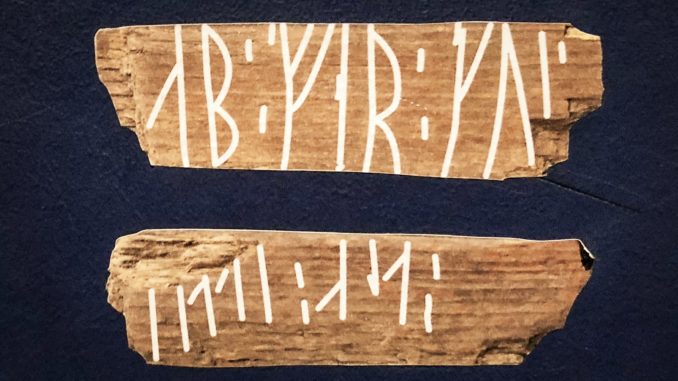
Runes are the letters of some Germanic languages, used before the adoption of the Latin script and Christianity. Runes were also used for divination. According to Hovamol [Hávamál] (Sayings of the High One, the Elder Edda), Odin learned the secret of the Runes while hanging from the ancient oak Yggdrasill for nine days and nine nights, pierced by the spear Gungnir as a sacrifice to himself:
Wounded I hung on a windswept gallows
For nine long nights,
Pierced by a spear, pledged to Odhinn,
Offered, myself to myself
The wisest know not from whence spring
The roots of that ancient rood
They gave me no bread,
They gave me no mead,
I looked down;
with a loud cry
I took up runes;
from that tree I fell.
Out of his desire to become the wisest God, Odin also sacrificed his eye. The importance of Odin’s sacrifice to himself is best seen in the fact that victims of the ritual human sacrifice to this god would often be pierced by the spear, and ritual hangings had particular importance in the worship of Odin. Odin was often referred to as the Lord of the Gallows or the Hanging God (Hangadrott).
There are two versions of how mortal men learned the secret of the Runes.
According to Rigsthula (Rigsþula, the Elder Edda), Heimdal [Heimdallr] raised three sons, ancestors of three classes: serfs (Thrall), farmers (Karl) and nobles (Jarl). To Jarl he passed the secret of the Runes.
Another version speaks of a man named Kettil Runske who stole three Rune staffs from Odin, thus learning the Runic magic. The story was presented by exiled Swedish archbishop Olaus Magnus in his Historia de Gentibus Septentrionalibus (1555).
Three best known Runic alphabets are the Elder Futhark [Fuþorc] (150 to 800 A.D.), the Anglo-Saxon Futhorc [Fuþark] (400 to 1100 A.D.) and the Younger Futhark (800 to 1100 A.D.). The Younger Futhark would later evolve into three Runic systems: Marcomannic Runes, Medieval Runes and Dalecarlian Runes.
The name Futhark is an acronym for the first six Runes (Fehu, Uruz, Thurisaz, Ansuz, Raidho, Kenaz). The difference in pronunciation (Futhark and Futhorc) is due to different voicing of the vowels in Germanic languages.
Runes were widely used for divination, healing and many other magical purposes. Runic magic is called Seid [Seiðr]. Women practitioners of Runic magic were called Völva (plural Völur), while some anglicized sources refer to them as Spákona (plural Spákonur) or Seiðrkona. Men practitioners of Runic magic were called Seiðrmadr. The literal translation of the word Völva is “the one who carries the Rune staff”. The term was sometimes used for Seiðrmadr as well. Archeological discoveries show that Völur were members of the high society, which is plainly seen from the rich graves they were buried in.
Meaning of the Runes is described in Hávamál (stanzas 147-165). Today, there are three interpretations of the Runes (Runic poems): the Icelandic Rune poem, the Norwegian Rune poem and the Anglo-Saxon Rune poem.
* References:
- Hovamol: http://www.sacred-texts.com/neu/poe/poe04.htm
- Rigsthula: http://www.sacred-texts.com/neu/poe/poe14.htm
Proudly WWW.PONIREVO.COM



